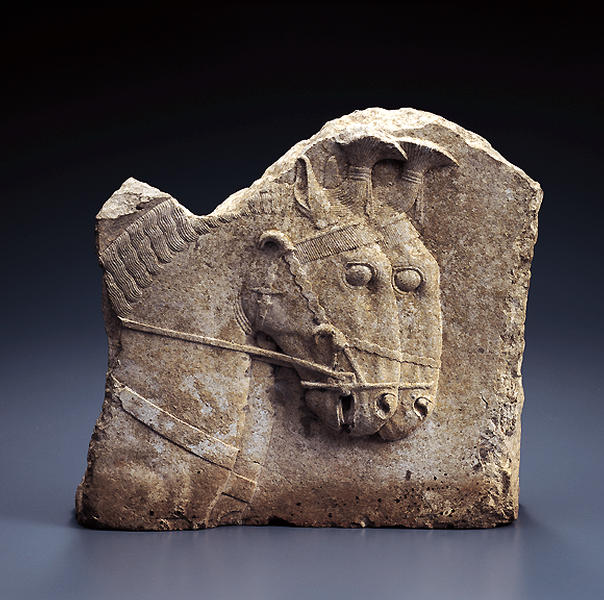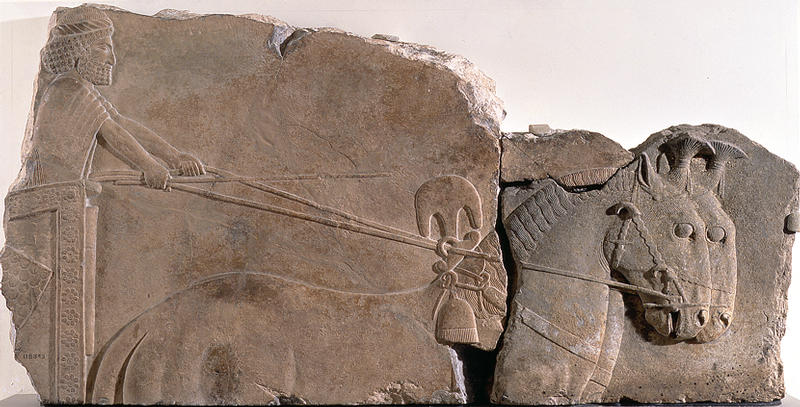Relief with Two Horses
- Iran, Persepolis
- Persia, Achaemenid period
- Darius(522 - 486B.C.) Xerxes(486 - 465 B.C.)
- Limestone
- H-37.7 D-9 W-38.1
Catalogue Entry
Through a series of dramatic building projects, Darius I (r. 522-486 B.C.), the successor to Cyrus the Great, firmly established the characteristics of Persian art and architecture under the Achaemenid dynasty. The most notable of his commissions was begun in 518 B.C. -Persepolis, a royal residential palace constructed on a broad terrace, with an enormous columned assembly hall or apadana. During following decades, Persepolis was enlarged with a series of independent, yet complementary buildings, constructed largely by his son, Xerxes (r. 486-465 B.C.), and grandson, Artaxerxes I (r. 465/4-425 B.C.).
Originally about twelve buildings were constructed on the Persepolis terrace, with elegantly carved reliefs adorning fa軋des, imposing stairways, doors, and window jambs. The predominant theme is the glorification of the king--who is shown in repetitive scenes walking through the palace, enthroned, or receiving tribute from international delegations from regions of the empire.
This fragment of relief from the Shumei collection was probably part of the East Wing of the monumental Northern Stairway of the apadana begun during the reign of Darius and completed by Xerxes, in about 470 B.C.1 The elaborate scenes of this stairway depict the Persian king receiving tribute from twenty-three delegations of foreign subjects, including among many others, Lybians, Syrians, Egyptians, Elamites, and Medes. Flanking the king are his attendants, guards, grooms, and royal chariots. The Shumei relief joins a larger fragment (88 x 56 cm) now in the British Museum2 that shows the backs of two horses and a chariot and driver. Both fragments probably came from the rearmost chariot from the East Wing of the Northern Stairway.3 A nearly identical chariot and driver depicted in mirror image remains in situ on the Eastern Stairway of the apadana, where the scenes of delegations and royal attendants are reversed.4
The two chariot horses of the Shumei fragment are exquisitely rendered, with great attention to modeling and the fine detail of trappings. They may be identified as Nesaean horses,5 a small compact breed characterized by a strongly arched neck and depicted during the Achaemenid period on stone reliefs, architectural sculpture, and precious objects (see cat. no. 35). As in other examples from Persepolis,6 the horses are shown with forelocks tied into standing tufts with twice-bound ribbons, an upright mane indicated by ornamentalized wavy strands, and sharply carved parallel creases at the juncture of the neck. In the Shumei relief, the horn-shaped attachments of the bridle7 are attached to wavy straps, the throatlash bears an elaborate toggle, and the browband is further enhanced with a line of fringe. The cheekpieces are straight, with rectangular rein attachments and figured ends in the form of hooves. The artist successfully conveys the impression of depth through high relief and naturalistic modeling of the horses, and attention to subtle details such as the clear depiction of the far rein of the first horse, visible between the horse's neck and body.
This fragment was probably acquired at Persepolis in July 1811, by Sir Gore Ousely, British Ambassador to Teheran (1810-15). It was donated by an heir, Sir Frederick Ousely, to St. Michael's College, Tenbury.8 Upon the closure of the college in 1985, the piece was consigned to auction at the Leominster sale of Russel, Baldwin, and Bright in May 1990, and later to Sotheby's in December 1990.9
NT
1. Roaff 1983, p. 138.
2. London, British Museum 118843: Barnett 1957, pl. xv (3). I am very grateful to have received this information and the detailed provenance of the Shumei relief from Dr. John E. Curtis, keeper of the Department of Western Asiatic Antiquities of the British Museum, personal correspondence, 28 February 1997.
3. For extant wall with lower portions of scene see Schmidt 1953, pl. 57.
4. Schmidt 1953, pl. 52; or Walser 1966, pl. 85 (upper).
5. Littauer and Crouwel 1979, pp. 148-49, fig. 80.
6. Roaff 1983, pp. 38-40, pl. XIIa-e.
7. These attachments have been identified by M.A. Littauer and J.H. Crouwel as "birds' beaks or boars' tusks" (Littauer and Crouwel 1979, p. 151) and are represented by excavated finds at Persepolis in Carnelian, white chalk, and limestone (Schmidt 1957, pl. 79.3-5).
Relief with Two Horses
The sheep-resembling heads are of Nisean horses, a breed native to the Media region of Western Iran, drawing the chariot of the Persian king. The images the Greek artisans of Asia Minor carved for the palace at Persepolis were ironically preserved in the earth, their contours unchanged despite the fall of the Persian empire. The Nisean horse was greatly treasured in Eurasia, both east and west, and it was to play an important role in the birth of the Silk Road after Emperor Wu of the Han dynasty named it the "heavenly horse" (Ch. tianma).

